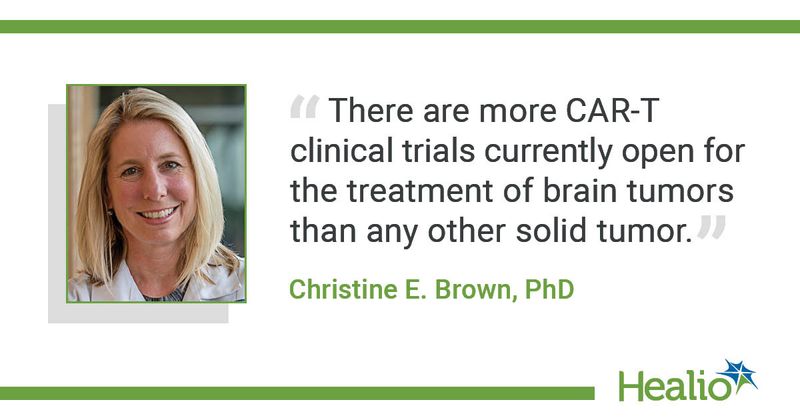As CAR-T advances into solid tumors, glioblastoma emerges as area of opportunity
Results of early clinical trials suggest that chimeric antigen receptor T cells can be adapted successfully to target brain tumors, according to a presenter at AACR Virtual Special Conference: Brain Cancer.
A phase 1 analysis of one next-generation CAR T-cell therapy showed it may target and kill tumor cells while eliciting an immune system response to help aid in that effort, according to Christine E. Brown, PhD, Heritage Provider Network professor in immunotherapy and deputy director of the T Cell Therapeutics Research Laboratory at City of Hope’s Beckman Research Institute.

“It's been incredibly exciting to see CAR T-cell therapy over the past few years being integrated into clinical care for treatment-refractory hematologic malignancies,” Brown said during a presentation. “This clinical success has been built on advances in both basic and translational research.”
The research that supported approval of commercially available CAR T-cell therapies took approximately 3 decades.
Making the transition from blood cancers to solid tumors has proven challenging, but it is “a major focus” for City of Hope’s CAR-T program, Brown said. Her lab has been focused on developing and optimizing CAR T cells to treat malignant brain tumors, including glioblastoma.
“The question remains whether immunotherapy — such as CAR T cells — can improve outcomes compared with standard of care,” Brown said. “This is clearly a tough problem and an unmet medical need, as malignant brain tumors — and particularly glioblastoma — pose many challenges to immunotherapy.”
Turning enthusiasm into opportunity
Central nervous system tumors pose many challenges, Brown said. One is their highly invasive nature in areas of extreme sensitivity. These tumors also are highly immunosuppressive, and the blood-brain barrier limits access to immune cells and other therapeutic agents.
“Even with these challenges, there are opportunities for CAR T cells,” Brown said. “There is a lot of enthusiasm to evaluate and optimize CAR T cells for the treatment of malignant brain tumors. There are more CAR-T clinical trials currently open for the treatment of brain tumors than any other solid tumor.”
One trial that Brown and colleagues are conducting will assess a locoregionally delivered IL13R-alpha-2-directed CAR-T for treatment of adults with relapsed or refractory glioblastoma. Patients will receive at least three infusions of CAR T cells administered intracranially.
“Locoregional delivery of CAR T cells — either delivered into the tumor or into the [cerebrospinal fluid] — outperform CAR T cells when they are delivered systemically or intravenously,” Brown said.
Initial results demonstrated that weekly dosing of CAR T cells is safe at all dose levels studied, with “no dose-limiting toxicities or flu-like symptoms” and only a few clinically manageable grade 3 events, Brown said.
Despite the single-center design and small study population, data from a cohort of patients whose therapy was optimized for dose level and manufacturing process showed median OS of 10.5 months among heavily pretreated patients whose disease progressed after prior therapy, Brown said. By comparison, historical data showed approximate median OS of 5 months to 9 months for patients with recurrent glioblastoma.
Engaging the host
Brown said she is encouraged by the median OS data in the optimized treatment cohort. Her group now is analyzing why certain patients achieved a particularly good response to CAR T cells.
One patient they evaluated had high levels of endogenous CD3 T cells before therapy, and analysis suggested that CAR-T doses resulted in an influx of the body’s endogenous T cells into the CNS fluid for some patients.
“There may be an interaction between CAR T cells and the host immune system,” Brown said.
Her lab is looking to answer questions about whether CAR T cells stimulate or promote endogenous immune responses, in addition to what role the endogenous immune system has in “productive” CAR T-cell therapy for solid tumors.
Previous research performed in Brown’s lab suggested CAR T-cell therapy potentially induces or expands antitumor by activating a patient’s endogenous T cells.
“We believe that the level of immune infiltration is an important biomarker for the responsiveness to CAR T-cell therapy due to the promotion upon interaction with host immunity,” she said. “CAR T cells may induce tumor immune reactivity and/or antigen spreading.”

